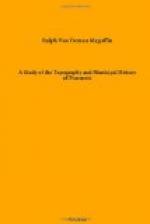Sulla built a huge temple on the second terrace higher than the old temple, but its fame and sanctity were never comparable to its beauty and its pretensions.[129]
THE EPIGRAPHICAL TOPOGRAPHY OF PRAENESTE.
AEDICULA, C.I.L., XIV, 2908.
From the provenience of the inscription this building, not necessarily a sacred one (Dessau), was one of the many structures on the site of the new Forum below the town.
PUBLICA AEDIFICIA, C.I.L., XIV, 2919, 3032.
Barbarus Pompeianus about 227 A.D. restored a number of public buildings which had begun to fall to pieces. A mensor aed(ificiorum) (see Dict. under sarcio) is mentioned in C.I.L., XIV, 3032.
AEDES ET PORTICUS, C.I.L., XIV, 2980.
See discussion of temple, page 42.
AEDES, C.I.L., XIV, 2864, 2867, 3007.
See discussion of temple, page 42.
Aedes sacrae, C.I.L., XIV, 2922, 4091, 9== Annali dell’Inst., 1855, p. 86.
See discussion of temple, page 42.
AERARIUM, C.I.L., XIV, 2975; Bull. dell’Inst., 1881, p. 207; Marucchi, Bull. dell’Inst., 1881, p. 252; Nibby, Analisi, II, p. 504; best and latest, Delbrueck, Hellenistische Bauten in Latium, I, p. 58.
The points worth noting are: that this aerarium is not built with reference to the temple above, and that it faces out on the public square. These points have been discussed more at length above, and will receive still more attention below under the caption “Forum.”
Amphitheatrum, C.I.L., XIV, 3010, 3014; Juvenal, III, 173; Ovid, A.A., I, 103 ff.
The remains found out along the Valmontone road[130] coincide nearly enough with the provenience of the inscription to settle an amphitheatre here of late imperial date. The tradition of the death of the martyr S. Agapito in an amphitheatre, and the discovery of a Christian church on the Valmontone road, have helped to make pretty sure the identification of these ruins.[131]
We know also from an inscription that there was a gladiatorial school at Praeneste.[132]




